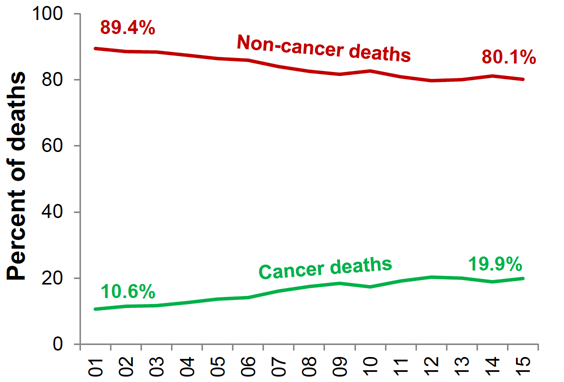As the overall death rate among people with HIV has fallen, the population’s cancer-related death rate has risen as a result of increasing rates of various cancers not related to the virus. The aging of the HIV population may drive this phenomenon, considering that close to a majority are now age 50 or older and many of these non-HIV-related cancers are age-related.
These findings come from an analysis of the HIV population in New York City. Home to one of the largest numbers of people living with the virus, the city has seen about 240,000 people diagnosed with HIV or AIDS since the start of the epidemic. About 117,000 have died there of HIV-related causes as of 2015. That year in particular, HIV-related diseases were still the leading cause of death among HIV-positive New Yorkers, at 31 percent, followed by cancer, at 21 percent, and cardiovascular disease, at 17 percent.
Presenting their findings at IDWeek 2017 in San Diego, researchers analyzed data from the NYC HIV Surveillance Registry, looking at information on individuals age 13 or older who were alive at any time between 2001 and 2015.
The study population included 152,883 people with HIV, 72.1 percent of whom were male. The bulk of the individuals were between 25 and 54 years old. A total of 45.3 percent were Black, 32.7 percent were Latino and 19.6 percent were white. A total of 34.9 percent were men who have sex with men, 20.8 percent were injection drug users (IDUs) and 42.4 percent were heterosexual. Forty-six percent of the population had a most recent CD4 count below 500 and 39.2 percent had a CD4 test result of 500 or higher (14.8 percent had missing data on their CD4 count).
During the 15-year study period, 22.1 percent (34,190) of the population died, of whom 82.4 percent (28,182) died of noncancer-related causes. A total of 15.4 percent (5,271) of the deaths were cancer related, including 33.1 percent that were due to HIV-related cancers, and 66.9 percent (3,524) that were due to non-HIV-related cancers. Out of all the deaths, among the 17,978 (53 percent) related to HIV, 10 percent (1,747) were due to HIV-related cancer; and among the 15,476 (45 percent) of all non-HIV-related deaths, 23 percent (3,542) were due to non-HIV-related cancer.
The proportions of deaths from non-HIV-related cancer among males were as follows: lung, 28 percent (699 people); liver, 19 percent (474); colorectal, 9 percent (233); pancreas, 6 percent (141); and oral, 4 percent (109). Among females, the proportions were: lung, 34 percent (341); breast, 14 percent (138); colorectal, 8 percent (82); liver, 8 percent (78); and pancreas, 5 percent (53).
As for deaths from HIV-related cancers, the breakdown among males was as follows: non-Hodgkin’s lymphoma, 59 percent (740 cases); and Kaposi’s sarcoma (KS), 9 percent (115). For women the figures were: non-Hodgkin lymphoma, 47 percent (233); cervical, 19 percent (93); and KS, 2 percent (12).
Between 2001 and 2015, the proportion of deaths from HIV-related cancers among the HIV population remained essentially stable, beginning at 4.4 percent and ending at 4 percent of all deaths. During this period, the proportions of deaths related to all cancers rose from 10.6 percent to 19.9 percent while the non-HIV-related cancer proportion rose from 6.1 percent to 15.9 percent. In other words, the rising proportion of deaths related to cancer was driven by a marked increase in the proportion of deaths from non-HIV-related cancer.

The proportion of annual deaths between 2001 and 2015 among New York City’s HIV population that died from cancer versus non-cancer-related causes.Ramaswamy C, Westheimer E, Braunstein S, Cancer mortality among persons with human immunodeficiency virus infection, New York City, 2001-2015. Oral abstract presented at: IDWeek 2017; 2017 Oct 10; San Diego, CA.

The proportion of annual deaths between 2001 and 2015 among New York City’s HIV population that died from cancer versus non-cancer-related causes. Ramaswamy C, Westheimer E, Braunstein S, Cancer mortality among persons with human immunodeficiency virus infection, New York City, 2001-2015. Oral abstract presented at: IDWeek 2017; 2017 Oct 10; San Diego, CA.
The average age at death among the study population increased steadily between 2001 and 2015, from 46 years old to 56 years old.
Compared with those age 65 and older, the younger age brackets had the following reduced risk of dying of non-HIV-related cancers: 55- to 64-year-olds, 30 percent reduced risk; 45- to 54-year-olds, 60 percent reduced risk; 35- to 44-year-olds, 80 percent reduced risk; 25- to 34-year-olds, 90 percent reduced risk; and 13- to 24-year-olds, 100 percent reduced risk (meaning none died from such forms of cancer).
Additionally, compared with heterosexuals, IDUs had a 1.5-fold increased risk of dying from non-HIV-related cancer. Compared with those whose last CD4 count was 500 or greater, those with a recent CD4 count below 200 had a 9.3-fold increased risk of such a death, while those with a CD4 count of 200 to 349 and 350 to 499 had a respective increased risk of 5.3-fold and 2.8-fold. And compared with those whose last viral load test indicated they were virally suppressed, those with an unsuppressed test result were 1.1-fold more likely to die of a non-HIV-related cancer.
The study authors stressed the importance of cancer screening among people with HIV, in particular liver and colon cancer screening for men, and breast and cervical cancer for women. Helping patients to quit smoking is also very important.







1 Comment
1 Comment